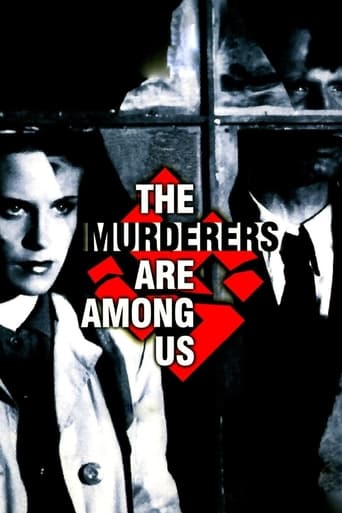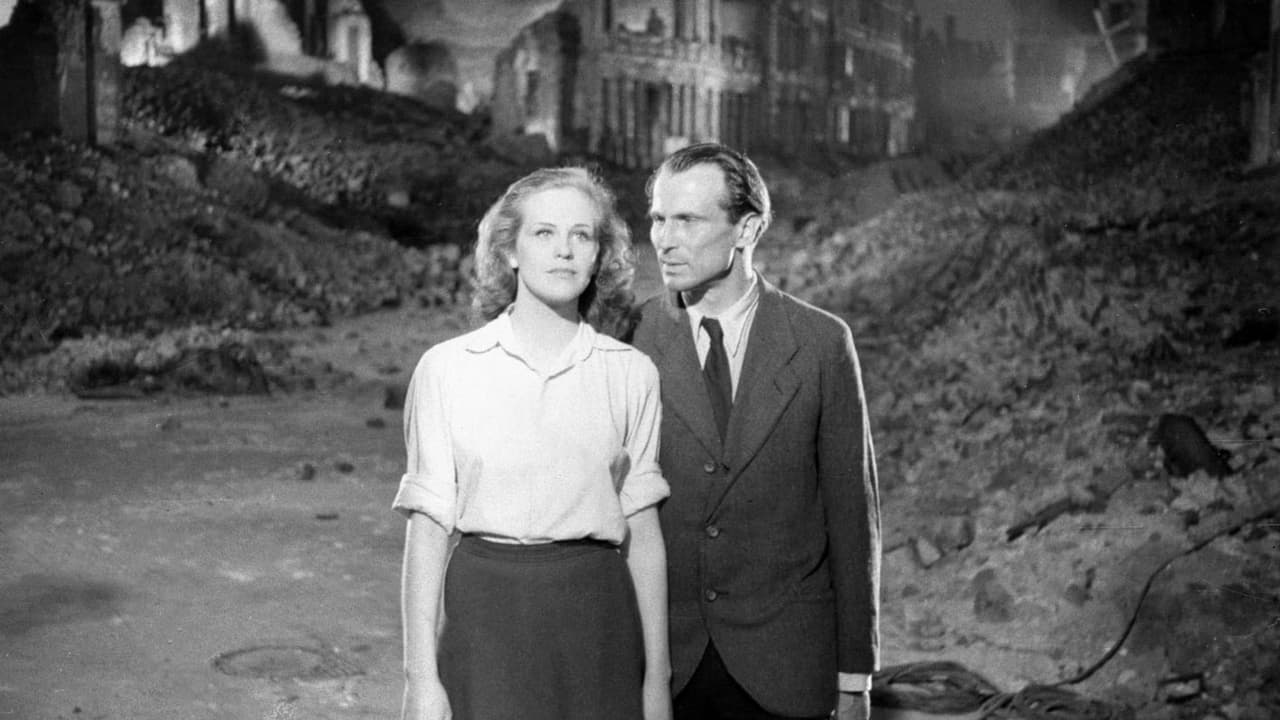Horst in Translation (filmreviews@web.de)
"Die Mörder sind unter uns" or "The Murderers Are Among Us" is a German black-and-white film from 1946, so this one has its 70th anniversary this year already. Writer and director is Wolfgang Staudte and he sure did not waste any time in trying to begin the German coming to terms with the events of the last 10 years. This one is about a man who fought in World War II, but it plays after the war already and the core of the movie is the man running into one of his commanders from the days of war, a man who instructed him and other soldiers to kill many innocent people, including women and children. In theory, this is a very interesting plot, but somehow I was not too well entertained by this story, not half as much as I hoped I would be.And then there is, of course, also the story of Hildegard Knef's character. Knef is certainly the most known actress from the cast here and still a name people now in Germany of the 21st century. I am afraid this cannot be said about Staudte or lead actor Wilhelm Borchert. But back to her character: She plays a woman after the war who comes back home from a concentration camp and tries to live a somewhat normal life again. Her character is mostly included to soothe the emotional pain of Borchert's character, but honestly, she did almost absolutely nothing for me. Her story could have been so much more interesting with her character's background and early on she seemed as much of a lead as Borchert, but the longer the film ran, the more her character disappeared out of the focus, only to get in fully again, pretty much out of nowhere, at the climax scene in the end.I believe the story of these two people had a lot more potential than the filmmaker managed to deliver us here. This could have been one of the truly great films made right afterward World War II, because it was so spot-on with the life at this period and the political impact it had. I also believe the actors, especially the lead actor were better than they could show us here because of the baity script that eventually lacks depth though. This is not a problem of the runtime. The film is fairly short, barely makes it to 80 minutes, but yet lacks focus considerably. I do not recommend "Die Mörder sind unter uns". Thumbs down for this great idea lost in execution.
dlee2012
Die Mörder Sind Unter Uns was made in the immediate aftermath of the Second World War and is a brave film to present to a Germany grappling to come to terms with twelve years of horror under the Nazi regime.Filmed partly on location, it is a sad and eerie pictorial record of the almost completely destroyed remnants of the once-beautiful city of Berlin. This location filming would have grounded the film very much in the here-and-now for the original audience, who would be able to identify with the characters' plight as they themselves struggled to survive from day to day amongst the rubble with the ever-present threats of starvation, disease and the occupying forces.Techniques taken from film noir are applied in this radically different context to great effect, emphasising the bombed cityscape's desolation as a backdrop for these damaged characters to play out their roles against. Just as stark is the music, which comes in short bursts throughout the film.The film's moral conundrum centres on what kind of justice should be meted out to the war criminals from the old regime. A doctor, shell-shocked and disillusioned, has lost his will to practice, feeling that saving individual lives is hopeless after the large-scale military massacres he has witnessed.His life becomes entangled with that of a former concentration camp detainee who tries to restore his will to live and heal his shattered nerves. He then comes across a former army officer, who ordered a massacre, living without any remorse not far away.Hildegard Knef is in fine form in this early role. Her radiant, youthful beauty stands in stark contrast to the bleak wreckage-strewn landscape around her. She is able to put suffering behind and help guide the broken doctor onto the path of redemption.There is a wonderful irony in the scene in which the doctor, preparing to kill the army officer, is instead called away to save a life.In saving the young girl, he is also recalling himself to life. The scene also serves to highlight the terrible effects of war: Berlin, formerly the most civilised and cultured city on the planet, no longer has basic medical supplies or equipment and it is the innocent civilians who are the ones who are suffering.Also ironic is the fact that the atrocity which haunts the doctor happened at Christmas. The military had turned a time of reconciliation and hope into a time of butchery. Perhaps the director is indicating that humanity had not matured one iota since Herod's massacre of the innocents.The end scenes, whilst melodramatic, are effective. The Doctor's shadow looms like an angel of vengeance over the military officer, dwarfing him as he shrivels from an arrogant leader and his cowardly inner nature is exposed. Knef intervenes at the last moment, dissuading the doctor from carrying out his vengeance attack and the army officer is instead taken into custody for a formal investigation and trial.Knef's pleas are more effective than those from most virtuous heroines given her own background as a concentration camp survivor. Her concern for the doctor leads her to realise revenge will be a path of destruction. These themes are highlighted by the end of the film, in which the camera zooms from a row of graves (presumably those of the civilians butchered in the army massacre) onto a single crucifix as a portent of Christ's own suffering and forgiveness.Ultimately, this film shows the after-effects of the war on civilians. The effects are both material as they pick up their broken lives in their shattered city that lacks even basic infrastructure and medical supplies and psychological, as they attempt to deal with the traumas they have experienced. Ironically, it is the perpetrators of the war, who seem to have suffered least, feeling no guilt or remorse and picking up their lives more easily than the humble civilians.More generally, the film raises questions of the role of justice. Is it a form of vengeance or is there more to it than that? A court hearing may help heal the mental wounds the victims have experienced and uncovering the truth of what happened may allow the City to move forward. Likewise, hopefully by its unflinching look at the horrors of the past half-decade, this film helped to heal the suffering citizens of Berlin, too, and helped them face the future with hope of redemption.
Karl Self
This is a very strange movie. It starts with the text insert "Berlin, 1945", which translated to "the same place, but last year" at the time and place of filming. Although Berlin sure was in ruins at the time, everything seems so neat, cosy and tidy here -- it made me wish for those happy days of being bombed out and living hand-to-mouth. Susanne, the concentration camp survivor, is perfectly made up and groomed in every scene. When she returns from the camps and finds the alcoholic misanthrope Dr Mertens squatting in her flat, she naturally falls heels over head in love with him. Dr Mertens has the fetching characteristic of never having to worry about food or fuel, and being able to party every day in nightclubs despite being pennyless. Strangely, most films that came years later managed to paint a more realistic picture of the post-war chaos than the film that was filmed right in the thick of it. There is also a somewhat overwrought old man, Mondschein, waiting for the return of his son from the war.The movie finally gains momentum when Mertens encounters his former commander, Ferdinand Brückner, who on Christmas eve only a few years ago ordered the execution of a hundred civilians. Brückner is an unscrupulous, jolly bastard, who has always managed to stay on top and is now already a successful entrepreneur. Compared to the other rather ethereal characters of the story, he is truly creepy because he is realistic, remorseless -- and strangely likable. In the original plot, Mertens eventually avenges himself and murders Brückner, but in order not to promote lynch justice, the movie takes a more moderate and open ending.The movie is very courageous in that it doesn't aim to entertain or send out a positive vibe, but confronts the uncomfortable past head-on and dares to hold up a mirror at its audience, in a way that few, if any, movies have done since. For that, and for its historic value, it deserves twenty out of ten points. Sadly it lacks a bit in suspense. On a side note, its brilliant cinematography and especially the masterly use of shadows was reciprocated in another classic that was filmed two years later, with almost an overload of suspense: The Third Man.
FilmCriticLalitRao
"Die Morder sind unter uns" is a film about guilt,helplessness and incapacity.Its story is told through two main protagonists: Dr.Mertens (Ernst Wilhelm Borchert) and Suzanne Wallner (Hildegard Knef).Mertens is a doctor by profession yet he is an angry man as he hates the fact the war has killed countless innocent people. He is horrified to personally experience that in all wars pawns are always sacrificed to save the king. It is equally hard for the photographer Suzanne Wallner to forget her past. She gets tremendous shock as upon her arrival she finds that her city has turned into a pitiful heap of rubble. Both of them are lonely souls.In this film there is a villain too. He appears in the form of an evil Nazi man Bruckner.Die Morder sind unter uns was the first film made by DEFA (Deutsche Film Aktiengesellschaft). It might appear rather unusual but this film has film noir kind of looks. Expectations were very high with this film. Staudte was triumphant to have created a ground-breaking film. In the original version of the script Bruckner is shot by Mertens.This end was changed on the wishes of the Soviet Cultural officer Dymshitz as he reckoned that a notion of self justice should not be propagated.Staudte was fortunate enough to have Soviet side willing to produce the film as it was rejected by English and American military authorities.Die Morder sind unter uns occupies a unique place in world cinema history as it established the antifascist genre in DEFA film.


 AD
AD



